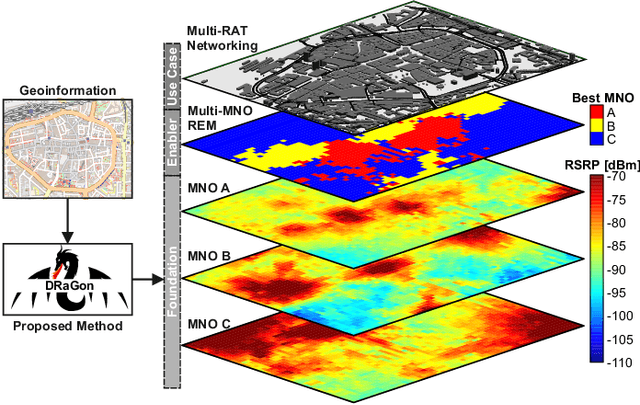Caner Bektas
Phase-Based Breathing Rate Monitoring in Patient Rooms Using 6G Terahertz Technology
May 25, 2023Abstract:The 6G standard aims to be an integral part of the future economy by providing both high-performance communication and sensing services. At terahertz (THz) frequencies, indoor campus networks can offer the highest sensing quality. Health monitoring in hospitals is expected to be an application site for these. This work outlines a 6G-enabled monostatic phase-based system for breathing rate monitoring. Our conducted feasibility study observes motion measurement accuracy down to the micrometer level. However, we also find that the patient's pose needs to be considered for generalized applicability. Thus, a solution that leverages multiple propagation paths and beam orientations is proposed.
DRaGon: Mining Latent Radio Channel Information from Geographical Data Leveraging Deep Learning
Dec 15, 2021



Abstract:Radio channel modeling is one of the most fundamental aspects in the process of designing, optimizing, and simulating wireless communication networks. In this field, long-established approaches such as analytical channel models and ray tracing techniques represent the de-facto standard methodologies. However, as demonstrated by recent results, there remains an untapped potential to innovate this research field by enriching model-based approaches with machine learning techniques. In this paper, we present Deep RAdio channel modeling from GeOinformatioN (DRaGon) as a novel machine learning-enabled method for automatic generation of Radio Environmental Maps (REMs) from geographical data. For achieving accurate path loss prediction results, DRaGon combines determining features extracted from a three-dimensional model of the radio propagation environment with raw images of the receiver area within a deep learning model. In a comprehensive performance evaluation and validation campaign, we compare the accuracy of the proposed approach with real world measurements, ray tracing analyses, and well-known channel models. It is found that the combination of expert knowledge from the communications domain and the data analysis capabilities of deep learning allows to achieve a significantly higher prediction accuracy than the reference methods.
 Add to Chrome
Add to Chrome Add to Firefox
Add to Firefox Add to Edge
Add to Edge